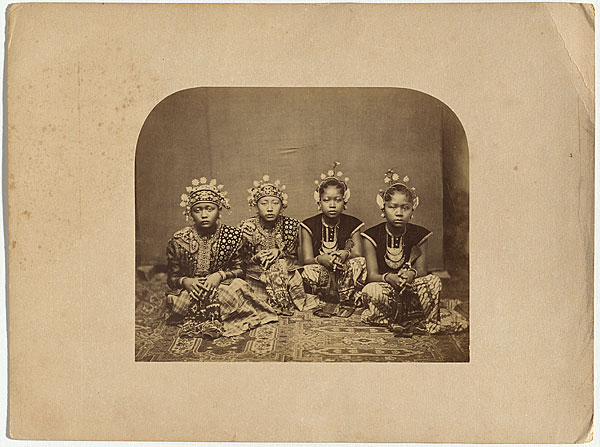Walter Woodbury
Manchester, England 1834 – Margate, Kent, England 1885
(Melbourne 9 October 1852; Batavia June 1857-1863; England 1863)
Serimpies, or dancing girls of the Sultano c.1858

- Photograph in the National Gallery of Australia collection:
The Leo Haks collection of 19th and early 20th century Asian photography, acquired 2007.
Serimpies, or dancing girls of the Sultano is one of the earliest known photographs of Javanese people and comes from a series on court dancers and musicians made circa 1858 by the Woodbury & Page studio of Batavia.
Englishmen Walter Woodbury (1834-1885) and James Page (1833-1865), having previously worked as photographers in Victoria, arrived in Java from Australia in 1857, setting up a studio that year.
The image of serimpi dancers is one of a number of stereographs on glass sold to London publishers Negretti and Zambra apparently in 1859 when Woodbury made a visit to London. The image of the dancers was reproduced as an engraving in the Illustrated London News, 31 July 1861.
A Negretti and Zambra catalogue of circa 1864 lists the image under the title Serimpies, or dancing girls of the Sultano among a number of scenes from Batoe Toelis near Buitenzorg (Bogor) in the hills of west Java.
Woodbury alone appears to be the author of the serimpi dancers picture as a small print of the subject appears in his personal album held in the National Museum of Photography, Film and Television in Bradford, England.
Court dancers, usually drawn from the ranks of royal families, were trained from childhood in the graceful and demanding movements of Javanese dance drama.
One pair of girls in the Woodbury picture is wearing the traditional matching serimpi costumes.
However, the Gallery's Senior Curator of Asian Art, Robyn Maxwell, has observed that the dancers are of different ethnic appearance and the check pattern costumes are south Sumatran in style. The models may be local girls wearing dance costumes.
By 1864 Walter Woodbury had returned to England but the Woodbury and Pagestudio remained in business with family members and others as operators until 1912.
Walter continued to work in photography until his death in 1885, most notably inventing the Woodburytype printing process. James Page died in Java in 1865.
Gael Newton
Former Senior Curator, Australian and International Photography
National Gallery of Australia
this text originally published on the NGA site
more Essays and Articles
|